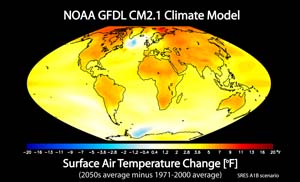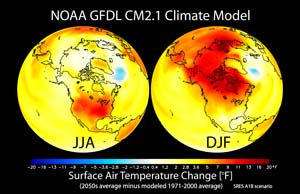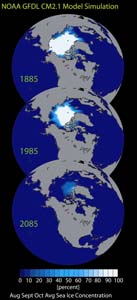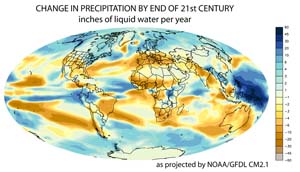| NOAA Magazine || NOAA Home Page |
NOAA SUPPORT FOR IPCC: PEOPLE, EXPERTISE, TECHNOLOGY
 Feb.
2, 2007 � NOAA individuals and technology
made major contributions to the Intergovernmental Panel on Climate Change
(IPCC) international climate science
report, of which the summary of the first chapter was released today
in Paris. That summary, the Summary for Policy Makers, was subjected
to line-by-line approval of the participating governments. (Click
NOAA image for larger view of projected change in annual mean surface
air temperature from the late 20th century (1971-2000 average) to the
middle 21st century (2051-2060 average). The change is in response to
increasing greenhouse gases and aerosols based on a "middle of
the road" estimate of future emissions. Click
here for high resolution version. Please credit “NOAA.”)
Feb.
2, 2007 � NOAA individuals and technology
made major contributions to the Intergovernmental Panel on Climate Change
(IPCC) international climate science
report, of which the summary of the first chapter was released today
in Paris. That summary, the Summary for Policy Makers, was subjected
to line-by-line approval of the participating governments. (Click
NOAA image for larger view of projected change in annual mean surface
air temperature from the late 20th century (1971-2000 average) to the
middle 21st century (2051-2060 average). The change is in response to
increasing greenhouse gases and aerosols based on a "middle of
the road" estimate of future emissions. Click
here for high resolution version. Please credit “NOAA.”)
| News
Audio (mp3), NOAA Climate Scientists Discuss Latest U.N. Climate
Panel Report |
| Media
teleconference with NOAA climate scientists discussing IPCC report.
Details
here. 49:00 |
| News conference at the Department of Energy in Washington, D.C. |
| Energy Secretary Samuel Bodman introductions and opening statements. 4:57 || 3:57 |
| NOAA Administrator Conrad Lautenbacher opening statement. 4:11 |
| EPA Administrator Stephen Johnson opening statement. 2:47 |
| News conference Q&A. 29:02 |
The IPCC was created in 1988 by the World Meteorological Organization and the United Nations Environment Program to every six years assess the risk of human-induced climate change, potential impact and options for adaptation and mitigation. The report is issued throughout the year through the release of three chapters culminating in a synthesis report in November.
"The depth of NOAA's contributions in this international effort, from a leadership role, providing observations, data, model simulations, analysis, authors and review editors, highlight the preeminent science conducted by our agency," said Vice Adm. Conrad C. Lautenbacher, Jr., U.S. Navy (Ret.) undersecretary of commerce for oceans and atmosphere and NOAA administrator. "The efforts contribute to NOAA's goal to understand climate change and variability to enhance society's ability to plan and respond."
Susan Solomon, a senior scientist of the NOAA Earth System Research Laboratory in Boulder, Colo., is co-chair of Working Group 1 (WG1), the Physical Science Basis. Nine of the lead and review authors are from NOAA and 20 of the model runs were done by the NOAA Geophysical Fluid Dynamics Laboratory in Princeton, N.J. Lead authors are nominated by their governments.
 NOAA
authors and IPCC review editors for WG1 include Thomas Peterson, David
Easterling, Thomas Karl, Sidney Levitus, Mark Eakin, Matthew Menne of
the NOAA Satellite and Information
Service; and Venkatachala. Ramaswamy, David Fahey, Ronald Stouffer,
Isaac Held, Jim Butler , Paul Ginoux, John Ogren , Chet Koblinsky, Dian
Seidel, Robert Webb, Randy Dole, Martin Hoerling of the NOAA
Office of Oceanic and Atmospheric Research, and Arun Kumar of the
NOAA National Weather Service.
Roger Pulwarty of OAR is an author for Working Group 2, Impacts, Adaptation
and Vulnerability, slated for release April 5. (Click NOAA image
for larger view of GFDL CM2.1 model-simulated change in seasonal mean
surface air temperature from the late 20th century (1971-2000 average)
to the middle 21st century (2051-2060). The left panel shows changes
for June July August (JJA) seasonal averages, and the right panel shows
changes for December January February (DJF). The simulated surface air
temperature changes are in response to increasing greenhouse gases and
aerosols based on a "middle of the road" estimate of future
emissions. Click
here for high resolution version. Please credit “NOAA.”)
NOAA
authors and IPCC review editors for WG1 include Thomas Peterson, David
Easterling, Thomas Karl, Sidney Levitus, Mark Eakin, Matthew Menne of
the NOAA Satellite and Information
Service; and Venkatachala. Ramaswamy, David Fahey, Ronald Stouffer,
Isaac Held, Jim Butler , Paul Ginoux, John Ogren , Chet Koblinsky, Dian
Seidel, Robert Webb, Randy Dole, Martin Hoerling of the NOAA
Office of Oceanic and Atmospheric Research, and Arun Kumar of the
NOAA National Weather Service.
Roger Pulwarty of OAR is an author for Working Group 2, Impacts, Adaptation
and Vulnerability, slated for release April 5. (Click NOAA image
for larger view of GFDL CM2.1 model-simulated change in seasonal mean
surface air temperature from the late 20th century (1971-2000 average)
to the middle 21st century (2051-2060). The left panel shows changes
for June July August (JJA) seasonal averages, and the right panel shows
changes for December January February (DJF). The simulated surface air
temperature changes are in response to increasing greenhouse gases and
aerosols based on a "middle of the road" estimate of future
emissions. Click
here for high resolution version. Please credit “NOAA.”)
In addition, a cadre of NOAA scientists from the laboratories and programs, including the joint and cooperative institutes, served as contributors and government reviewers of the final report, which is a state of the science based upon published peer-review literature. For this report, more than 5,000 scientific publications are referenced.
 The
NOAA National Weather Service, through the NOAA
National Centers for Environmental Prediction participated through
climate reanalysis efforts. IPCC uses climate reanalysis data sets to
document climate trends and to verify climate change model simulations
from 1950 to the present. (Click NOAA image for larger view
of sea ice concentrations simulated by the GFDL CM2.1 global coupled
climate model averaged over August, September and October—the
months when Arctic sea ice concentrations generally are at a minimum.
Three years (1885, 1985 & 2085) are shown to illustrate the model-simulated
trend. A dramatic reduction of summertime sea ice is projected, with
the rate of decrease being greatest during the 21st century portion.
The colors range from dark blue—ice free—to white—100
percent sea ice covered. Click
here for high resolution version. Please credit “NOAA.”)
The
NOAA National Weather Service, through the NOAA
National Centers for Environmental Prediction participated through
climate reanalysis efforts. IPCC uses climate reanalysis data sets to
document climate trends and to verify climate change model simulations
from 1950 to the present. (Click NOAA image for larger view
of sea ice concentrations simulated by the GFDL CM2.1 global coupled
climate model averaged over August, September and October—the
months when Arctic sea ice concentrations generally are at a minimum.
Three years (1885, 1985 & 2085) are shown to illustrate the model-simulated
trend. A dramatic reduction of summertime sea ice is projected, with
the rate of decrease being greatest during the 21st century portion.
The colors range from dark blue—ice free—to white—100
percent sea ice covered. Click
here for high resolution version. Please credit “NOAA.”)
The Climate Reanalysis effort at NCEP started in 1995. The first reanalysis, a collaborative effort by NOAA National Centers for Environmental Prediction and the National Consortium on Atmospheric Research is maintained and extended in real time at NCEP as a continuous real-time operational climate monitoring tool. The updated CDAS data sets are distributed internationally via various channels.
Arun Kumar, deputy director of the NOAA Climate Prediction Center, also participated in the U.S. review of the WG1 report.
The NOAA Satellite and Information Service provided numerous observational data sets from satellites and surface-based data that were critical to the assessment related to a wide variety of ocean and atmospheric climate variables.
 NOAA's
investment in enhanced computing power at the NOAA Geophysical Fluid
Dynamics Lab made it possible for the lab to provide 20 model runs to
the IPCC. GFDL is one of 12 international centers participating in the
IPCC.
NOAA's
investment in enhanced computing power at the NOAA Geophysical Fluid
Dynamics Lab made it possible for the lab to provide 20 model runs to
the IPCC. GFDL is one of 12 international centers participating in the
IPCC.
These models used two of the lab’s coupled models, which incorporate data from the ocean, atmosphere, sea ice and land surface. These two models were among 23 used for the IPCC. One of the WG1 chapters focuses on the improvement of the climate models since the last IPCC report in 2001. (Click NOAA image for larger view of change in annual average precipitation projected by the NOAA Geophysical Fluid Dynamics Laboratory CM2.1 model for the 21st century. Blue areas are projected to see an increase in annual precipitation amounts, and brown areas are projected to receive less precipitation in the future. Click here for high resolution version. Please credit “NOAA.”)
Many of the IPCC efforts were supported through the U.S. Climate Change Science Program and the NOAA Climate Program Office. For example, the U.S. Climate Change Science Program Synthesis and Assessment Report on temperature trends, led by NOAA, was a key input used in the IPCC Assessment.
NOAA, an agency of the U.S. Commerce Department, is celebrating 200 years of science and service to the nation. From the establishment of the Survey of the Coast in 1807 by Thomas Jefferson to the formation of the Weather Bureau and the Commission of Fish and Fisheries in the 1870s, much of America's scientific heritage is rooted in NOAA. NOAA is dedicated to enhancing economic security and national safety through the prediction and research of weather and climate-related events and information service delivery for transportation, and by providing environmental stewardship of the nation's coastal and marine resources. Through the emerging Global Earth Observation System of Systems (GEOSS), NOAA is working with its federal partners, more than 60 countries and the European Commission to develop a global monitoring network that is as integrated as the planet it observes, predicts and protects.
Relevant Web Sites
NOAA
Climate Research Highlights: Graphics, Simulations, Animations
What Is Climate and Why Do We Model It?
Media
Contact:
Jana Goldman, NOAA
Research, (301) 713-2483 or Kent
Laborde, NOAA, (202) 482-5757